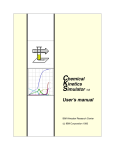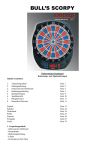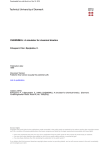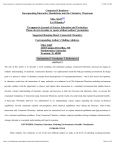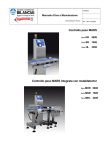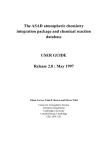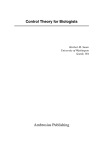Download User`s manual
Transcript
A Software Package for the Numerical Modeling of Complicated Chemical Reaction Kinetics KINET (version 1.2.5) User’s manual 2 KINET User’s Manual 1. AIMS AND CAPABILITIES OF KINET KINET is intended to provide help in studying chemical kinetics. Given the description of a reaction mechanism as a set of equations, KINET automatically draws a corresponding set of differential equations and calculates kinetic curves for all substances taking part in the reactions. During the computation process, the results are plotted on screen for detailed observation and examination and/or printed as a table if desired. Besides the simulation of the kinetics at given rate constants and initial concentrations, i.e., solving the direct kinetic problem, KINET makes it possible to solve so-called reverse kinetic problems that deal with the determination of the rate constants of one or more elementary stages. To tackle the reverse problem, it is necessary to supply the experimental data on the concentrations of some substances at various consecutive moments in time. KINET will optimize the constants to reach the best possible agreement between the calculated and experimentally measured concentrations. When solving chemical kinetics problems, the so-called “stiff systems” of differential equations are often encountered. These occur if the rates of the elementary stages differ by multiple orders of magnitude. It is almost impossible to obtain a solution to a stiff differential equation system with common numerical methods, such as Runge-Kutta, or Adams algorithms. KINET employs Gear's algorithm that is especially suitable for integrating such systems and makes it possible to find solutions to chemical kinetics equations at almost any given rate constant value. The abilities of KINET are limited to the following: maximum number of elementary stages maximum number of substances maximum number of data points per experimental curve total number of data points - 20 - 15 - 20 - 50 The elementary stages can be mono-, bi-, and trimolecular; up to 8 substances can participate in each elementary stage; obviously, quite enough for all realistic needs. This version of KINET is intended for MS-DOS operating system. It can also work successfully in all Windows-systems (in a form of DOS-window or console task). But while working in Windows environment following restrictions exist: 1) long file names are forbidden (only 8.3 format is allowed, i.e. maximal length of name is 8 symbols, maximal length of extension is 3 symbols). 2) graphical output is possible only in full-screen mode and the standard VGA-graphics is used (resolution 640x480, 16 colours). Since the graph has been plotted, the program can be switched to window mode (by pressing Alt-Enter). However, user can not interact with the program in this mode. 2. EQUIPMENT NEEDED a. IBM PC compatible computer with DOS 3.0 or higher b. 640 K RAM c. math co-processor to significantly increase computation speed, otherwise, calculation time for complex problems may take too long. d. color EGA or VGA for graphics capabilities to be fully realized; monochrome EGA, VGA, CGA, or Hercules are suitable as well, but it may be difficult to identify graphics curves shown on the screen. KINET User’s Manual 3 3. OVERVIEW OF INSTRUCTIONS TO USERS KINET consists of two files, KINET.EXE and KINET.BAN. These must be in the same directory on floppy or hard disk. During operation, a 60 Kb temporary file will be created on disk; make sure the disk has enough free space and it is addressable for writing. To run KINET, simply type KINET and press ENTER. No command-line parameters are necessary. If the computer has a Hercules video card, Microsoft's driver MSHERC.COM should be installed before KINET is run, otherwise, it will be impossible to use the graphics mode. When KINET comes up, the "KINET" logo is shown. Continue by pressing any key. The following menu will be presented. Choose the desired action by entering its corresponding number. Enter new data View & edit the data Load data from a file Save data in a file View kinetic curves Calculate concentrations at one point in time Optimize rate constants (inverse problem) Quit 1 2 3 4 5 6 7 ESC Usually, just after accessing KINET, initial data needs to be entered using the keyboard (the 1st menu item), or downloading from a file (the 3rd item). The latter choice is applicable if data saved from a previous session is desired. Previous versions of the program used binary format for storing data, so it was impossible to edit it with text editors. The present version of KINET recognizes both binary (files with .kin extension) and text formats (files with .txt extension). To familiarize yourself with the syntax of data storage, you can just view attached files of the demonstrational problems. The data, once entered, can be saved in a file for later use (4th menu item) or downloaded from a file, viewed and edited (2nd menu item). New data may also be viewed and edited employing this option as well. With the initial data entered, proceed to solving the direct, or reverse, kinetic problem. To solve the direct problem select either the 5th or 6th menu item. These items are independent and differ only in that the 5th item will initiate the calculation and graph representation of the kinetic curves up to the stated reaction time; while the 6th selection will initiate the calculation of the concentrations of all substances at different given moments of reaction time, the result being output to a file. This selection facilitates obtaining a numerical representation of the results as a table that can be printed out. This file can also be used as a source of future input data for some standard graph software packages (MS Excel, Origin). To solve the reverse problem - to optimize the values of the rate constants using the criteria of the best agreement between the experimental data and the kinetic curves calculated with a given mechanism choose the 7th menu item. 4. DATA INPUT AND EDITING The initial data consist of three parts: a. a reaction mechanism, i.e., a set of elementary reactions and corresponding rate constants; b. the initial concentrations of substances; 4 KINET User’s Manual c. the experimental data, i.e., the values of concentrations of one or more substances at various moments in reaction time. The latter is mandatory only for solving the reverse problem; if only the calculation of kinetic curves is desired, the experimental data may be omitted. 4.1 First-time data input. Data input (1st menu item) begins with the determination of the reaction mechanism. Each elementary reaction is presented as a common chemical equation. To denote substances, use arbitrary identifiers consisting of up to 8 symbols -- these must be letters or numbers, but, the first symbol must always be a letter. These identifiers of substances are case-sensitive, that is, KINET distinguishes lower-case from upper-case letters in substance names -- PRODUCT1 and product1 will be treated as different names. The underscore sign (_) is recognized as a letter. The equal sign (=) divides the leftmost and rightmost parts of an equation. Substance identifiers are divided with the plus (+) sign. Example: H + Cl = HCl A=B+Pr_1 As seen above, spaces between the parts of an equation are not required; however, there must be no spaces in the names of substances. There may be a stoichiometric coefficient before a substance name but no space is necessary. The following equations are equivalent: H+H=H2 2H=H2 2 H=H2 Only the numbers 1, 2, or 3 can be the stoichiometric coefficients, as only mono-, bi-, and trimolecular reactions are allowed, that is, no more than 3 molecules can take part in any one elementary reaction. Fractional stoichiometric coefficients are obviously NOT allowed. One can indicate a rate constant for an equation by ending the equation with a semicolon (;), and 'k=value'. Example: H + Cl = HCl; k = 1.23e10 N2O4 = 2 NO2; K=125 As seen above, both lower- and uppercase letters 'k' are allowed. Equation input ends by pressing the ENTER key. If the rate constant for the equation just entered is not indicated, the cursor will move to the right of the screen. KINET will ask that the rate constant be entered. If a syntax error occurs in the input equation, KINET will highlight the error found; a corresponding diagnostic message will appear, accompanied by a sound signal. Press any key and repeat the input. When a reaction mechanism definition is complete, press ENTER just after KINET asks for the next elementary equation, i.e., input a blank line instead of an equation. After 20 elementary equations have been input, the definition will be completed automatically. KINET User’s Manual 5 Once a mechanism has been input, KINET will proceed to the input for the initial concentrations. For each substance a corresponding prompt will be displayed: [substance]= Input a numeric value as an answer to each prompt. If ENTER is pressed and no value has been entered, KINET will assume zero value. This allows faster input since the concentration of a substance at the initial moment of a reaction most frequently equals zero. Input errors will be treated exactly as described above. After input of the initial concentrations, KINET will ask whether experimental data will be entered. The default is NO (N); to refuse entering experimental data, simply press ENTER. If it is necessary to enter experimental data, KINET will ask: a. the name of the substance for which the kinetic curve is to be defined; b. number of the experimental data points for the curve; c. pairs of values 'time-concentration' for each point. The values for the time and the concentration are divided with a space or comma. After entry of the indicated number of data points, KINET will display the input values for correction if necessary. Any corrections required may only be made here because further corrections will be impossible. After completing an experimental curve for one substance, KINET will again ask for a substance name, number of points, and so on until it receives an empty line (ENTER) instead of a substance name. In entering the data, there are no limitations imposed on the order of data points, i.e., they need not necessarily go in the order of reaction time increase and the agreement between moments of reaction time for points that belong to different curves is not necessary. 4.2 Editing initial data. The 2nd menu item allows browsing and alteration of the initial data. In the present KINET version, editing capabilities are limited to changing rate constants and initial substance concentrations. If the reaction mechanism requires alteration, re-enter the whole data set. As stated above, it is impossible to edit the experimental kinetic curves. The current data will be shown again part by part. After each part KINET will inquire whether changes need to be made. The default is NO (N). If no alterations are needed, simply press ENTER after each part is shown. If alterations are needed, type 'Y' (YES). KINET will return to part one (rate constants) and ask for the number of each elementary equation where a rate constant needs changing. The cursor goes to that line deleting the original value. Type in a new rate constant. To complete editing, press the ENTER key without entering a value. KINET will proceed to part two (initial concentrations). If alterations are needed, enter as above, except, instead of the number of an equation, KINET will ask the name of the substance. 5. STORING INITIAL DATA IN A FILE After the initial data has been entered, it can be written to a file and later loaded and used for a new calculation, altering, if necessary, the values for rate constants and initial concentrations as described above. 6 KINET User’s Manual Choose the 4th menu item to write current data to a file. KINET will ask for a file name and automatically attach the file extension .TXT. The name of the file should meet the DOS format (maximal length of name is 8 symbols, maximal length of extension is 3 symbols). The file is always created in the current directory. To load data from a file (3rd menu item), enter a filename minus the extension. Data may be repeatedly written using different filenames, or loaded from different files during one KINET session. Choosing the 1st or 3rd menu item will delete the current data set from memory but leaving intact the data stored in files. KINET considers the last file saved or read as the current data - set name. This name will be used in the case of a 'void' answer to the next filename inquiry. When the 6th menu item is chosen, the current filename will be used as a label for the file containing results from the computations. In this case, the extension .DAT will be added to the filename. 6. SOLVING A DIRECT KINETICS PROBLEM. There are two methods (modes) in solving the direct kinetics problem: automatically creating and displaying kinetic curves, and a concentrations calculation at given moments in reaction time. The latter has the capability of recording its results in a file as a time-concentration table. These two methods (modes) are represented by the 5th and 6th menu items. 6.1 Graph mode. When the 5th menu item is chosen, KINET will ask for a final reaction time, i.e., the reaction time over which a calculation is to be performed. A reaction time always starts at zero. After the final reaction time input, KINET will switch to graph mode, with X- and Y- coordinate axes displayed. The X-axis scale will be determined by the given final reaction time, the Y-axis scale will be chosen from a maximal initial concentration. KINET displays the kinetic curves during the computation run on this graph. After the completion of the computation, the points corresponding to experimental data will be shown as well, if that data has been input. To display and understand the colors corresponding to each particular substance, and to change Xand Y- axis scales, use the F1, F2, and F3 function keys. Function key definitions are displayed on the information line at the bottom of the screen. A computation may be interrupted at any time before its completion by pressing the ESC key. To continue an interrupted computation is impossible but the parts of the kinetic curves already plotted may be used as if they were complete. The interruption capability saves computation time, if the curves show that the model's parameters and/or the final reaction time were determined improperly. On a color screen, each curve is plotted in its own color. To learn which substance corresponds to which color, press F1 – the color legends will appear in the upper right-hand corner. Using a monochrome display may produce difficulties in identifying particular curves. In this case, it is recommended to first compute substance concentrations at several points, using the 6th menu item in order to identify the curves later. Since concentrations of different substances may vary by orders of magnitude, some kinetic curves may be invisible, i.e., lie just on the X-axis or go beyond the limits of a chart. Varying the Y-scale with the F3 key allows easier examination of particular curves -- or their groups -- in greater detail. During a run, the computation results are written to a temporary file, therefore, consecutively changing the vertical Y-scale does not require re-computation and is relatively fast. It is desirable that the temporary file is on a hard or virtual disk. KINET User’s Manual 7 The F2 key facilitates changing the horizontal X-scale and giving another value for the final reaction time. As a rule, after altering the final time, kinetic curves will be re-computed. Only if a new value for the final time is less than the previous one and it differs by less than 25%, the curves will be plotted using the previous results. If computations are complete, pressing the ESC key switches KINET from graph mode, returning it to the main menu. If a computation is still running, pressing the ESC key will cause it to be interrupted. 6.2 Computation of time - concentration table. The 6th menu item facilitates the calculation of concentrations at a given moment of reaction time. KINET asks for a time value and outputs the corresponding concentrations for all substances. The results being printed on screen are simultaneously written to a file with the current filename and .DAT extension. If a file with the same name already exists, its contents will be left intact, the new data being appended to it. This allows compilation of the table in several steps. KINET makes it easy to create a time-concentration table with a uniform time interval between consecutive reaction times, by memorizing the interval between the two last moments of the reaction time for which the concentrations have been computed. Simply press ENTER without inputting a value and KINET will assume the interval to be equal to the previous one. For instance, to compute a change of substance concentrations during 10 minutes of reaction time with an interval of 0.25 seconds, enter the step value of 0.25 only once, then press the ENTER key thirty-nine times. It is not necessary that the moments of reaction time be entered in ascending order; however, each time the new value is less than the previous one, KINET will re-start computation from a zero reaction time. Therefore, consecutively increasing values of reaction time is more profitable from the viewpoint of the total time of calculation. To abort a computation and return to the menu, press ESC when KINET asks for a new value of reaction time. KINET will also return to the main menu if a 'void' answer (ENTER) is given after a negative or zero step. 7. SOLVING THE REVERSE KINETIC PROBLEM If the 7th menu item is chosen, the chemical reaction equations will be shown on the screen with their corresponding values of rate constants. KINET will ask for the numbers of the constants to be optimized. To enter these numbers, type them on one line, divided by commas or spaces. The values assigned these constants while entering the reaction mechanism will be considered as their initial approximations. KINET will vary these constants to reach a minimum sum of the squares of the deviations between the computed and the given experimental values of the concentrations. To minimize the sum of the squared deviations, the Powell method is employed. To observe the optimization process, KINET has the facility to output the results of each iteration, i.e., the current values for the constants being varied and the sum of the squared deviations will be printed to screen. If this option is not desired, KINET will print only the final solution for the optimized rate constants. Bear in mind, the computation time may be lengthy. After the completion of the rate constant optimization, KINET offers viewing of the kinetic curves. YES (Y) is the default. KINET will solve the direct kinetic problem just as if the 5th menu item was chosen, see 6.1 above. The new-found rate constants will be substituted for the primary values in the initial data set; for browsing, use the 2nd menu item, or save them by writing to a file using the 4th menu item. When a reverse kinetics problem is formulated, it should be taken into account that successful determination of a rate constant depends on which kinetic curves are presented in the experimental data. For example, in the case of a very simple kinetic scheme consisting of only two consecutive reactions: 8 KINET User’s Manual A --> B; rate constant k1 B --> C; rate constant k2 the kinetics of the consumption of substance A is determined only by the k1 constant and does not depend on k2; whereas, the kinetics of the formation of the final product C depends on both constants. If experimental results are known only for A, then it is possible to calculate only k1 but not k2, since different values of k2 will produce the same kinetics curves for A, if k1 is fixed. However, if an experimental curve for only C is known, it is possible to determine both the k1 and k2 constants. KINET recognizes situations like the one above and, on attempting to optimize values for constants not influencing given kinetic curves, a warning message is published. To proceed, eliminate the indicated constant from the list of the optimizible constants. It is necessary to bear in mind that cases may sometimes be encountered where the value of a rate constant has only a weak influence on some kinetic curves. KINET cannot recognize these situations since the constant can be theoretically optimized but its found value may prove unreliable. 8. DEMONSTRATIONAL PROBLEMS The KINET package includes 7 files with demonstrational problems: CONSECUT.TXT An ordinary consecutive reaction A→B→C. There is also data for solving reverse kinetic problem. MM.TXT A Michaelis-Menten kinetic scheme (fermentative kinetics). NO.TXT A high-temperature NO synthesis in N2-O2 mixture. ET.TXT A simplified scheme of ethane pyrolysis, which adequately depicts the initial stage of the process. OSCILL.TXT An oscillating reaction (a simplified scheme of Lotki-Volterra). BRUSSEL.TXT A more complicated example of the oscillating reaction (known as brusselator). ORGNATOR.TXT One more wide-known example of oscillating reaction, known as “oregonator”. (Examples on oscillating reactions were prepared by Kubasov A.A.).









